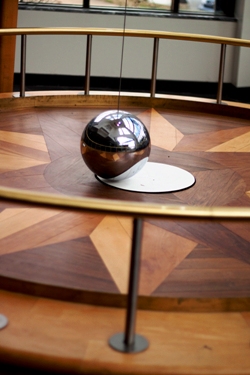
Foucault Pendulum

Located in Hickman's main lobby on the first floor is our very own Foucault Pendulum. Everyone knows the Earth rotates daily, but scholars searched for scientific proof for centuries. In 1851, French physicist Jean Bernard Leon Foucault (pronounced Foo-KO) discovered that a pendulum's swing plane changes its orientation as a result of the Earth's rotation.
Imagine a room with transparent wall located at the Earth's North Pole. A simple pendulum is set in motion with its plane of swing aligned with a star in the constellation Orion. As time progresses, the plane of swing of the pendulum remains aligned with the star, but its orientation to the room changes. Specifically, the pendulum precesses 360° every 24 hours. The swing plane did not move, but the Earth rotated beneath it!

In Collegedale, which is 35° north of the equator, a simple pendulum precesses 360° not in 24 hours, but in 41.84 hours (41.84=24/sine[35°]). As the pendulum bob swings from side to side, a very weak Coriolis force (proportional to its speed) exerts a varying sideways force to the right, which causes the swing plane to rotate.
If the pendulum were swinging in a perfect vacuum, its amplitude would not decrease over time. The air that the ball moves through tends to slow it down. To compensate for the energy lost to air resistance, a magnet located under the center of the base exerts a very small radial force to the ball each time it passes over.
The 200-pound ball hangs on a 38-foot multistrand aircraft cable and has been "working" since December 1999. Its period is 6.89055 plus or minus 0.00016 seconds.
The Walla Walla School of Engineering collaborated with the The School of Engineering and Physics (formly the Physics and Engineering Department) at Southern in designing and constructing the pendulum.